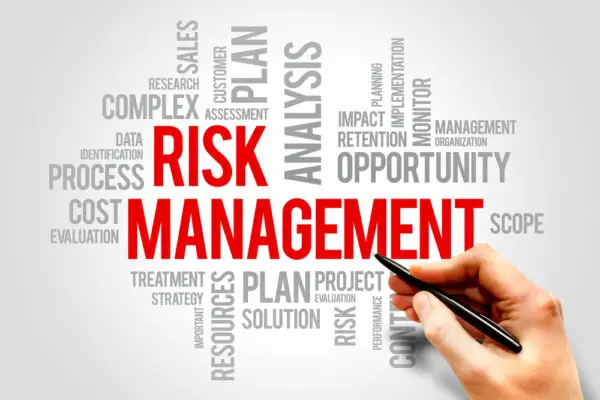Market risk, also known as “systematic risk” or “undiversifiable risk,” refers to the risk that the value of an investment could decrease due to changes in market factors. These factors can be broad, affecting the overall financial markets, and are typically outside the control of individual investors or companies.
There are several types of market risk:
Equity Risk: This is the risk that stock prices in general (not just the value of one particular stock) will fluctuate.
Interest Rate Risk: This is the risk that interest rate changes will negatively affect an investment’s value. For example, when interest rates rise, bond prices usually fall.
Currency Risk: Also known as exchange rate risk, this is the risk that changes in the value of foreign currencies will negatively affect the value of an investment. It is particularly relevant for businesses operating internationally or investors holding foreign assets.
Commodity Risk: This is the risk that changes in the price of commodities (like oil, gold, or agricultural products) will negatively affect investment. This is particularly relevant for businesses dependent on specific commodities and for commodity investors.
Economic Risk: This risk arises from changes in the overall health of the economy, such as changes in GDP growth, inflation, unemployment rates, and consumer spending.
Market risk cannot be eliminated through portfolio diversification, though it can be managed to some extent. Portfolio managers and individual investors use various hedging strategies, asset allocation, and other investment strategies to manage their exposure to market risk.
Market risk is essential to portfolio management and investment decision-making, as it affects the returns and risks of different investments.
Understanding market risk, its types, sources, measurement, and management strategies is crucial for investors seeking to optimize their portfolios.
Market risk can arise from various sources, such as interest rate movements, stock price volatility, exchange rate fluctuations, commodity price changes, geopolitical events or natural disasters.
These factors can affect the performance of individual securities or entire markets, leading to losses for investors who hold those assets.
Mitigating these risks effectively requires a deep understanding of market movements’ underlying causes and drivers and effective hedging strategies that align with investors’ objectives and constraints.
This article aims to provide an overview of market risk and how it affects investment decisions by exploring its different dimensions and implications for portfolio management practices.

Defining Market Risk
This type of risk cannot be eliminated through diversification and affects all securities traded in the market.
Investors are exposed to market risk since stock price fluctuations can impact investments such as stocks, bonds, and mutual funds. Changes in interest rates, inflation rates, geopolitical events or natural disasters can positively or negatively affect the performance of these investments.
For instance, if interest rates rise unexpectedly, bond values decrease while stock prices may increase due to investors selling off their bonds and investing more money into equity securities.
Market risk can be measured by beta, which measures an investment’s sensitivity to market movements. A security with a high beta will tend to move up or down more than the overall market, while the overall market’s direction will have less impact on low-beta security.
Investors who want higher returns must accept higher levels of market risk since achieving high profits without taking on some risk is difficult.
However, understanding how much exposure one has towards this type of financial vulnerability is essential when making investment decisions.
Types of Market Risk
There are several types of market risks that investors face when trading securities. These include:
- Equity Risk: The possibility of losses arising from fluctuations in stock prices.
- Interest Rate Risk: The chance that interest rates will change and affect investment returns.
- Credit Risk: The likelihood that borrowers default on their loans or bonds, resulting in financial losses for lenders.
- Currency Risk: The risk associated with changes in exchange rates that impact investment returns denominated in foreign currencies.
- Commodity Price Risk: The possibility of price fluctuations affecting oil, gold, and silver commodities.
Market volatility and pricing uncertainty make it challenging for investors to predict future outcomes accurately. Investors must be aware of these risks and take appropriate measures to mitigate them while making investment decisions.
Understanding the various types of market risks is critical for investors seeking to maximize their returns while minimizing their exposure to potential losses. Additionally, staying abreast with current market trends and developments is essential for successful investing.
Sources of Market Risk
These sources can be broadly classified into systematic and unsystematic risks. Systematic risks affect the entire market or a particular segment, while unsystematic risks are specific to individual assets.
One major source of market risk is interest rate fluctuations. Changes in interest rates impact borrowing costs for businesses, which in turn affects their profitability and stock prices.
Moreover, changes in interest rates also influence consumer spending patterns, which can significantly impact the economy as a whole. Investors can employ hedging strategies such as buying put options or shorting bonds to mitigate some of the impacts on investments caused by interest rate volatility.
Another source of market risk is geopolitical events. Wars, terrorist attacks, political unrest and trade wars can potentially disrupt global markets and cause instability across various asset classes.
In such situations, investors may find it challenging to predict how markets will react or how long any instability may last. Diversifying across geographies or asset classes is one-way investors may attempt to protect themselves against these risks.
Identifying and monitoring sources of market risk is critical for investors who seek to make informed investment decisions in an increasingly complex financial environment.
It’s impossible to eliminate all types of risk from an investment portfolio; employing appropriate hedging strategies alongside diversification could help reduce their impact on investments during periods marked by heightened volatility due to external factors beyond their control.

Measuring Market Risk
One crucial aspect of financial management is the accurate measurement and assessment of the potential impact of external factors on investment portfolios. Market risk, which arises from changes in market prices and can affect all investments, is one such factor that must be measured accurately.
The value-at-risk (VaR) approach is commonly used to measure market risk, with two popular methods being a historical simulation and a Monte Carlo simulation.
The historical simulation calculates VaR using past data to simulate potential future scenarios. It involves selecting a period for which historical data is available and generating hypothetical portfolio returns based on the distribution of actual returns during that period.
From this simulated distribution, the VaR at a given confidence level can be calculated as the loss that would not be exceeded over a specified holding period.
Monte Carlo simulation uses mathematical models to generate random variations within input parameters to simulate thousands or millions of possible outcomes.
Monte Carlo simulations enable investors to analyze how their portfolios might respond under different macroeconomic conditions.
This process applies statistical distributions to market variables such as interest and exchange rates based on historical behaviour. These simulations help investors identify risks beyond what may have been observed historically.
The value-at-risk approach provides an effective tool for measuring market risk using various techniques such as historical and Monte Carlo simulations.
Both methods provide valuable insights into potential losses an investment portfolio faces during adverse market conditions while also providing support in making informed decisions about asset allocation strategies to minimize exposure to these risks.
Managing Market Risk
Effective management of potential portfolio losses due to external factors requires a comprehensive strategy encompassing various methods, akin to how a skilled sailor navigates through different wind conditions by adjusting sail angles and rudder positions.
This is where risk mitigation comes in, which is the process of identifying, assessing, and prioritizing risks followed by coordinated efforts to minimize or eliminate them.
A well-designed risk management plan will significantly reduce the likelihood of financial loss from market fluctuations.
One common technique for managing market risk is hedging strategies, which involve taking an offsetting position in another asset or derivative contract. For instance, investors can use options contracts to protect themselves against declines in stock prices.
An investor who owns company shares may buy options on those shares as protection against a drop in price. The put option acts as insurance because if the share price does fall below the option’s strike price, the investor can sell their shares at that higher strike price.
Another method for managing market risk is diversification. By spreading investments across multiple assets and markets with low correlation coefficients between each other, investors can reduce their exposure to any single asset class or geographical region’s downturns.
Diversification aims to smooth out unsystematic risks while reducing overall volatility and providing better long-term returns for investors’ portfolios. However, it should be noted that diversification does not eliminate systemic risks such as global economic recessions or political instability affecting multiple markets simultaneously.
To sum up, managing market risk requires more than just measuring its potential effects; it involves developing effective strategies such as hedging techniques and diversifying portfolios across multiple asset classes and regions with low correlation coefficients between one.
While these methods cannot eliminate all risks associated with investing in volatile markets, they do provide a level of protection against significant losses while increasing opportunities for gains over time.
Frequently Asked Questions
How does market risk differ from other types of financial risks?
It refers to the potential for losses due to fluctuations in market prices, such as changes in interest rates, currency exchange rates, or stock prices.
Market volatility is a key driver of market risk and can be caused by various factors, including economic events, political instability or natural disasters.
Unlike other financial risks, such as credit or operational risks specific to particular assets or activities, market risk affects all investments across asset classes.
Risk management strategies are essential for investors looking to manage their exposure to market risk.
These strategies may include diversification across asset classes and regions, hedging using derivatives contracts, or adjusting portfolio allocations based on changing market conditions.
Can market risk be eliminated, or is it always present in investment portfolios?
The answer to this question is no, market risk cannot be eliminated. It is an inherent aspect of investing in financial markets.
However, there are mitigating strategies that investors can adopt to reduce their exposure to market risk. These strategies include portfolio diversification, hedging with options and futures contracts, and setting realistic limits on risk tolerance.
While these measures may not eliminate the market risk, they can help investors manage their exposure to it and limit potential losses during periods of market volatility.
How does the current economic climate affect market risk?
The current economic climate significantly impacts market risk, particularly in relation to inflation and interest rates.
Inflation can cause uncertainty in the economy, as it affects the purchasing power of consumers and the profitability of businesses. This uncertainty can lead to higher market volatility and increased risk for investors.
Additionally, interest rate changes can directly impact investment portfolios, as they affect the cost of borrowing and lending money. Higher interest rates may decrease consumer spending and lower corporate profits, reducing stock prices.
As such, it is crucial for investors to closely monitor these economic indicators when assessing their portfolio’s level of market risk.
Are any industries or sectors more susceptible to market risk than others?
According to a study by the International Monetary Fund, finance, energy, and technology industries are more susceptible to market risk than others. This is because these sectors experience greater volatility in their stock prices and can be heavily impacted by external factors such as changes in interest rates or geopolitical events.
However, there are various mitigating strategies that companies within these industries can employ to reduce their exposure to market risk.
These include diversifying their portfolios, hedging against potential losses, and closely monitoring market trends and economic indicators.
How do global events and political instability impact market risk?
Trade tensions and natural disasters are two examples of non-political global events that can significantly impact market risk. Trade tensions, for instance, refer to disputes between countries over tariffs and trade policies, which can lead to reduced economic activity, lower consumer confidence, and decreased investor sentiment.
Natural disasters such as hurricanes or earthquakes can also cause significant damage to infrastructure, disrupt supply chains, and reduce productivity in affected areas.
These events can affect different industries depending on their exposure to specific risks.
For example, companies with significant operations in regions prone to natural disasters may see a decline in revenues due to supply chain disruptions or physical damage to assets.
Overall, these non-political global events serve as a reminder that market risk is an ever-present factor affecting all sectors of the economy.

Conclusion
Market risk refers to the possibility of financial loss arising from changes in market conditions, such as fluctuations in interest rates, exchange rates or stock prices. It is a key investment management component and can impact individuals and businesses alike.
The different market risk types include interest rate, currency, equity, and commodity price risks. Sources of market risk stem from a range of factors, including economic conditions, political instability and global events.
Measuring market risk using various methods, including Value at Risk (VaR) and stress testing. Managing market risks requires a proactive approach through diversification strategies, hedging techniques and effective portfolio management.
Understanding market risk is crucial for investors making informed decisions about their portfolios.
Identifying potential sources of market volatility and implementing appropriate measures to manage the associated risks, investors can protect their investments from unexpected losses while capitalizing on growth opportunities.

Chris Ekai is a Risk Management expert with over 10 years of experience in the field. He has a Master’s(MSc) degree in Risk Management from University of Portsmouth and is a CPA and Finance professional. He currently works as a Content Manager at Risk Publishing, writing about Enterprise Risk Management, Business Continuity Management and Project Management.

